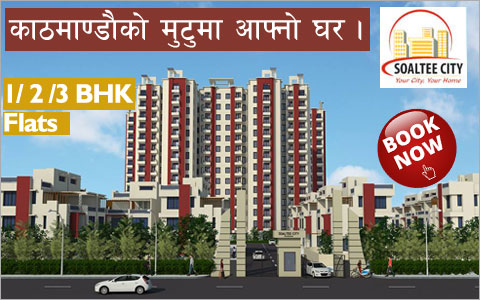National News

Government has not been able to win the confidence of landowners
In a bid to halt unplanned urbanisation by consolidating scattered and arbitrarily chopped plots of land, the government has initiated land pooling projects in various parts of Kathmandu valley.
The government claims that the value of land will obviously rise as the plot of land under this project will be facilitated with urban amenities like -roads, water supply, electricity, drainage, et cetera.
However, the government has not been able to win the confidence of landowners, as they need to provide certain areas of land for roads and open space. Moreover, land owners are also required to pay a certain amount as tax. The government was supposed to invest around five to 15 per cent of the total cost of projects as per the provision on National Housing Policy (NHP) 2011 but has not done so in projects that have started.
Also as per existing policy, there is a provision for the government to acquire pieces of land and integrate them. However, there is another provision in which the government can approve land pooling project on request from 51 per cent of total landowners and assists them in planning and implementation of the project in cooperation with consumer groups. It is provisioned that there should be at least three per cent open space and 21 per cent of the total land has to be allocated for roads. However, it is an irony that almost all the land pooling sites are agricultural land.
“We are not happy with the on going land pooling project, which is spread over 534 ropanis of agricultural land,“ said Ratna Kumar Koju, chairperson of the consumers committee of Tumocho Dugure Land Pooling Project in Bhaktapur. Stat ing that landowners are only contributors to the project, Koju complained, “The government doesn't contribute anything to the project except for technical assistance.“
He urged the government to waive off the tax imposed on the project. According to him, they had to contribute 35 per cent of their land on average while a few had to contribute up to 57 per cent.
Accusing the government for not abiding by the detailed project report, he said, “There was commitment that the project will incorporate facilities like gravel road, drinking water, sewage line and electricity but we are facing a hard time and don't see these amenities.“ According to him, the price of the land, which was around Rs 300,000 per ropani some one-and-half decade ago, has appreciated to Rs 1.7 million per aana. “Till date around Rs 70 million has been spent on the project,“ he informed. The project initiated in 2005 was estimated to be accomplish within an investment of Rs 130 million.
Karuna Ratna Shakya, senior divisional engineer at Kathmandu Valley Development Authority (KVDA), said, “Land pooling is essential to maintain planned urbanisation. The project not only beautifies the city but also provides consumers with all urban amenities.“ According to KVDA, there are many ongoing land pooling projects like the ones in Ichhangu Narayan, Bagmati Nagar, Kamerotar, Tumocho Dugure and Dekocha Mitanche Itapake among others.Meanwhile, Nakkhudole, Kamal Vinayak and Libali land pooling projects are completed one in the valley.
Citing that they do not commence a project without the consent of landowners', Shakya said, “For conducting a land pooling project, there needs to be a request from 51 per cent of total landowners along with the local authority's recommendation.“ He informed that the actual contribution of landowners amounts to mere seven per cent while the rest of the contribution goes for roads, open spaces and others which are for their use. According to him, these projects are carried out on land measuring a minimum 100 ropanis to above 1,000 ropanis. “We are compelled to plan in agricultural land as there is no other option,“ explained Shakya, adding that they start projects only after conducting a feasibility study.
The Dekocha Mitanche Itapake project is in its initial phase, which is spread over 1,625 ropanis. Niraj Sainju, sub-engineer of the project, said, “We have already conducted a feasibility study of the project and will be soon working on it,“ adding that they have made six optional construction maps for the project. The project is estimated to be completed within an investment of Rs 1.57 billion.
source: Awale,Sujata (2014),"Land pooling could halt unplanned urbanisation", the himalayan times,1 March 2014
- 9th Nepal Buildcon International Expo 2024
- Real Estate Expo 2023
- NRB raises housing loan limit to encourage home constructions
- Nepal Rastra Bank (NRB) Monetary Policy 2080-2081
- New Price of Land in Kathmandu Metropolitan City, Nepal
- Capital Gains Tax Rate on Real Estate Transactions in Nepal 2080-81 ( 2023/24 )
- Kathmandu metropolis implements free parking policy for commercial buildings and hospitals

![[X]](https://www.housingnepal.com/images/popup-close-button.png)







































































































































































































































































































































































































































 Facebook
Facebook
 Delicious
Delicious
 Digg
Digg
 Reddit
Reddit
 Stumble Upon
Stumble Upon









